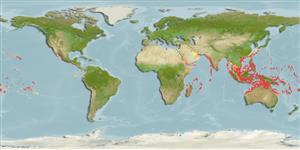Common names from other countries
Environment: milieu / climate zone / depth range / distribution range
Écologie
marin récifal; profondeur 5 - 65 m (Ref. 90102), usually 20 - 65 m (Ref. 27115). Tropical; 22°C - 28°C (Ref. 27115); 35°N - 25°S
Indo-Pacific: Red Sea and Kenya east to Hawaiian Islands, Fanning Islands and Samoa; northward to Japan south to Australia. Apparently not found off New Zealand (Ref. 8991).
Taille / Poids / Âge
Maturity: Lm ? range ? - ? cm
Max length : 45.0 cm SL mâle / non sexé; (Ref. 8991); common length : 35.0 cm SL mâle / non sexé; (Ref. 9645)
Épines dorsales (Total) : 3 - 4; Rayons mous dorsaux (Total) : 43 - 47; Épines anales: 1; Rayons mous anaux: 37 - 40.
Found on outer reef slopes, hovering above the bottom. They swim often high above the substrate to pick prey from the substrate with their excellent eyesight (Ref. 48635). Tends to swim away from its pursuer rather than enter its burrow (Ref. 1602). Solitary or in pairs (Ref. 9710), adults form monogamous pairs (Ref. 37816). Maximum depth from Ref. 027115.
Life cycle and mating behavior
Maturities | Reproduction | Spawnings | Egg(s) | Fecundities | Larves
Monogamous mating is observed as both obligate and genetic (Ref. 52884).
Dooley, J.K., 1978. Systematics and biology of the tilefishes (Perciformes: Branchiostegidae and Malacanthidae) with descriptions of two new species. NOAA Tech. Rep. NMFS Circ. No. 411:1-78. (Ref. 8991)
Statut dans la liste rouge de l'IUCN (Ref. 130435)
CITES (Ref. 128078)
Not Evaluated
Menace pour l'homme
Harmless
Utilisations par l'homme
Pêcheries: commercial; Aquarium: Commercial
Outils
Articles particuliers
Télécharger en XML
Sources Internet
Estimates based on models
Preferred temperature (Ref.
115969): 24.6 - 29, mean 27.9 (based on 1578 cells).
Phylogenetic diversity index (Ref.
82804): PD
50 = 0.6250 [Uniqueness, from 0.5 = low to 2.0 = high].
Bayesian length-weight: a=0.00537 (0.00236 - 0.01221), b=3.03 (2.82 - 3.24), in cm Total Length, based on LWR estimates for this (Sub)family-body shape (Ref.
93245).
Niveau trophique (Ref.
69278): 3.5 ±0.50 se; based on food items.
Fishing Vulnerability (Ref.
59153): Moderate vulnerability (42 of 100).
